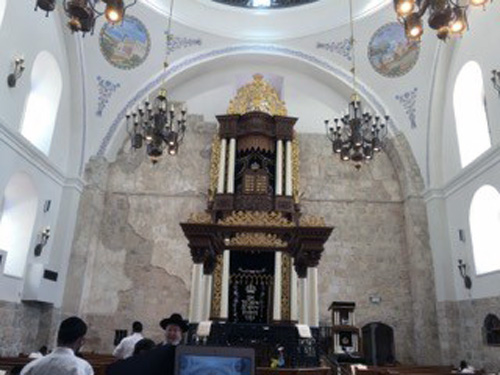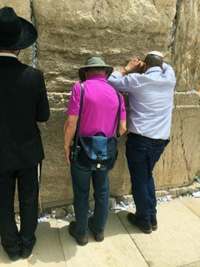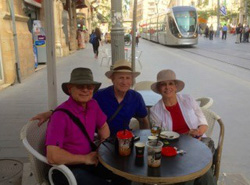
By Steve Kramer


ALFE MENASHE, Israel– How can a visitor experience the real Israel in seven days? If you’re my brother Charles, all you need do is hang out with us Kramers for a week. That just happened when my brother came to help Michal and me celebrate my birthday.
Charles arrived on a Friday, in time to join us and several friends for Shabbat dinner, always a special time of the week here. Whether hosting friends and family or being invited to dine at a friend’s home, there’s nothing like Israeli home hospitality. True, you can have the same type of Shabbat meal in the Diaspora, but here in Israel you get the full experience, with the majority of families sitting down to a family meal, regardless of their level of religious observance.
For Shabbat lunch, we went to Ra’anana to dine with friends at their beautiful home, a spacious penthouse. The weather was glorious and the company pleasant. After the abundant meal, we returned home to relax and prepare ourselves for the next part of the trip.
Sunday morning we headed towards Jerusalem. We interrupted the brief ride (an hour) to enjoy a short hike at a KKL-JNF park known for its agricultural terraces and pools. The Sataf site began around 6,000 years ago, in the Chalcolithic period, and terrace construction started around 4,500 years ago. Sataf attained its greatest size and splendor in the Second Temple and Byzantine periods. In more recent times, there was an Arab village which was abandoned during Israel’s War of Independence. Throughout the 1950s, the site was used as a training area by Israel Defense Forces’ paratroopers and Unit 101.” (www.kkl.org.il)
The park was quite crowded with school kids enjoying their spring excursions, as well as new army recruits being taken on cultural and historical tours to enhance their love of the land. Sataf’s agricultural terraces and pools, serving each of the two local springs, were rehabilitated by KKL-JNF starting in the 1980s, allowing visitors to observe hillside agriculture as it was practiced in Biblical times. There are various hikes throughout this area of the Judean hills, so we chose a relatively short one, to allow us plenty of time in Jerusalem.
JERUSALEM
Returning to the road, we soon reached the Mamilla Hotel, our home for the next few days. Located in the center of Jerusalem, this exclusive boutique hotel is ideally located between the Old City and the modern shopping and business district. In addition to great food and service, the hotel’s fitness facilities are terrific. The hotel is adjacent to the relatively new Mamilla Mall; both were built on what was briefly a “no man’s land” between 1948-1967, when Jordan occupied the older parts of the city. Those 19 years of occupation were the only time Jerusalem has been divided in its 3,000 year history.
After enjoying lunch at a Mamilla Mall cafe with a friend of Charles’ son, we rested before later exploring King David Street on the way to dinner. The main sites on our short walk were the iconic King David Hotel and, opposite it, the YMCA. The King David Hotel was built in 1931 with locally quarried pink limestone (typical of all Jerusalem buildings) and was founded by Ezra Mosseri, a wealthy Egyptian Jewish banker. It has grand style, with public rooms which replicate differing architectural styles from the city’s long history.
Besides being the usual hotel frequented by heads of state and other dignitaries, the hotel was the headquarters for the British military around the time of WWII. As such, it was the target of an explosion set in 1946 by militant Zionist forces, with casualties of more than 100 (91 fatalities). It is a fact that three telephone calls were made prior to the attack alerting people to flee the building; these warnings were ignored by the British.
The YMCA, with its elegant arches, domes and tower, was designed by the architect of the Empire State Building. It opened in 1933 and was described in the world press as a center of cultural, athletic, social and intellectual life. The building contains the Three Arches Hotel and restaurant in addition to numerous public and educational spaces.
Our destination for dinner was the new First Station entertainment area, on the grounds of the Ottoman era train station utilized by the Jaffa-Jerusalem train. Today the renovated building and grounds host events, galleries, shops and many restaurants. (A high-speed train line is currently under construction.) We had an excellent “Asian Fusion” meal at one of the many restaurants and then returned to the hotel, not missing out on window shopping at the many art galleries near the King David.
The next morning we walked to the Old City via the Mamilla Mall, a distinctive pedestrian walkway lined with new shops and reconstructed old buildings. On our way to the Western Wall (the Kotel), we stopped at the Broad Wall, a remnant of the ramparts of Israelite Jerusalem of the First Temple period (1,000 BCE). The 7-meter wide wall is exposed for a length of 45 meters. “The western section of the wall passes through the remnants of a house that was probably part of a neighborhood previously built outside the walls. Apparently evacuated by royal decree, the king’s engineers used some of the stones to fortify the wall,” at the time of the prophet Isaiah and King Hezekiah. (www.jewish-quarter.org.il)
We were too late to join the English tour at the Temple Institute, which proclaims: “Our short-term goal is to rekindle the flame of the Holy Temple in the hearts of mankind through education. Our long-term goal is to do all in our limited power to bring about the building of the Holy Temple in our time.” The Institute has constructed many sacred vessels for the service of the Holy Temple, which are on display in the museum. “They are made according to the exact specifications of the Bible, and have been constructed from the original source materials, such as gold, copper, silver and wood. These are authentic, accurate vessels, not merely replicas or models. All of these items are fit and ready for use in the service of the Holy Temple.” While we were only able to enjoy the museum shop and book store, it was still fascinating. (www.templeinstitute.org)
Visiting the Kotel is always uplifting. Making our way through the throngs descending from the Jewish Quarter to the Western Wall Plaza, we entered the imposing space in front of the Kotel, where you can see people from around the world, Jews, Christians, and that day, even Muslims on a tour. Charles and I entered the men’s section on the left, while Michal visited the smaller women’s section. There, touching the ancient stones which were part of the ramparts of the Temple Mount, built by King Herod in the 1st century BCE, we connected to our ancient Jewish heritage.
On our way out of the Old City, we stopped at the Jewish Quarter’s most spectacular site, the Hurva Synagogue. Originally named the Beit Ya’akov Synagogue, this reconstructed house of prayer is a replica of what was the largest, most magnificent and important synagogue in the entire Land of Israel, the center of life in the Jewish Quarter. It was totally destroyed by the Jordanians in 1949, after they conquered the Old City and took the remaining Jews away to prisoner of war camps in Jordan (then called Transjordan). Hurva, meaning “ruin,” aptly describes the synagogue, which was originally built by Jews and then destroyed by Arabs in the early 18th century CE, then rebuilt in 1864 as a much larger edifice.
After the Six Day War of 1967, a ceremonial arch was built to remind Jews of the twice-destroyed synagogue with its huge dome. Finally, in 2010 the synagogue was rebuilt in all its grandeur. Tours in English are available with advance reservations. (www.jewish-quarter.org.il)

Famished by this time, we made our way back to the “new” city to the Ben Yehuda pedestrian mall area. We satisfied our craving for street food with delicious falafel and shwarma, then wandered around the streets, especially Jaffa Road, a pedestrian-only street with the exception of the light rail system, a long term project which is in the process of being extended to more areas of Jerusalem. We stopped at one of the ubiquitous Israeli coffee shops on Jaffa Road before returning to the hotel.
That evening we met friends for a delicious fish dinner, accompanied by a myriad of freshly prepared salads. Like many eating places in Israel, the Ahavat Ha Yam restaurant is located above a gas station. It’s humble location was in no way an impediment to its popularity, as attested to by a crowd of secular and religious diners.
Before leaving Jerusalem the next morning we stopped at the renewed Israel Museum, which is celebrating its 50th anniversary this year. The museum, which is absolutely world-class, has wonderful archeological, Jewish heritage, and painting/photography sections, in addition to an outstanding sculpture garden and children’s museum. The renewal of the museum added much needed exhibition space as well as a better organized design, a more convenient entrance, and a large, excellent gift shop and numerous dining options. Charles and I enjoyed the Jewish heritage section, especially the reconstructed synagogues from around the world, while Michal toured several special exhibitions.
*
Next: Tel Aviv
*
Kramer is a freelance writer based in Alfe Menashe, Israel. Your comment may be sent to steve.kramer@sdjewishworld.com or posted on this website, provided that the rules below are observed.
__________________________________________________________________
Care to comment? We require the following information on any letter for publication: 1) Your full name 2) Your city and state (or country) of residence. Letters lacking such information will be automatically deleted. San Diego Jewish World is intended as a forum for the entire Jewish community, whatever your political leanings. Letters may be posted below provided they are responsive to the article that prompted them, and civil in their tone. Ad hominem attacks against any religion, country, gender, race, sexual orientation, or physical disability will not be considered for publication. There is a limit of one letter per writer on any given day.
__________________________________________________________________
Pingback: Eating and touring in Israel, Part 2 - San Diego Jewish World